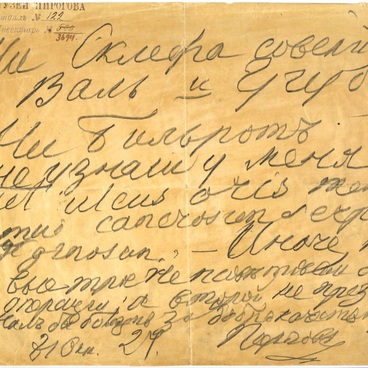The sculpture ‘Carrying the Wounded off the Battlefield’ was created specifically for the exhibition of the Military Medical Museum in 1946. It features a nurse’s aide carrying a wounded soldier in her arms with the help of a special strap. The sculpture is dedicated to the feat of women amongst the junior medical personnel — they were the ones who provided first aid on the battlefield .
Before the start of World War II, five orderlies were assigned to a regular infantry squad of 80 soldiers and officers led by a sergeant — the squad leader. They had only one handgun at their disposal, and it was the commanding officer who was in charge of it. Only during wartime, all the nurses and orderlies were allowed to have personal weapons. 40% of medical service staff were women.During the battle, the Nurse Corps always was ahead. According to the rules, when a nurse found a wounded soldier, she had to get close to him, ignoring enemy fire. She extinguished burning clothes, assessed the severity of wounds, provided first aid: stopped the blood, applied a bandage, and put a splint on an injured limb. Then the nurse, not forgetting to take the soldier’s weapon, carried him to the rear of the squad. There was a ‘casualty collection point’ already prepared — a place for temporary shelter. Craters from bombs and shells, as well as ruins, old trenches or small ravines were well suited for this. The wounded remained waiting for the stretcher bearers and transport, and the nurse returned to the front line to help other injured soldiers.
In the first year of World War II, the average life expectancy of a medical orderly on the battlefield was only 40 seconds. Only the servicemen of regular infantry squads died more frequently. Almost immediately, the work of orderlies was acknowledged equal to a military feat. In special order No. 281 as of August 23, 1941, military commanders established the procedure of awarding medals and orders to junior medical personnel.
The orderlies, who carried 15 wounded with their weapons off the battlefield, received a medal ‘For Battle Merit’ or ‘For Courage’. The Order of the Red Star was awarded for rescuing of 25 soldiers, the Order of the Red Banner — for 40 wounded, the Order of Lenin — for 80 wounded. Over the course of the war, 15 female medical workers received the title of Hero of the Soviet Union, many of them received it posthumously.
The orderlies, who carried 15 wounded with their weapons off the battlefield, received a medal ‘For Battle Merit’ or ‘For Courage’. The Order of the Red Star was awarded for rescuing of 25 soldiers, the Order of the Red Banner — for 40 wounded, the Order of Lenin — for 80 wounded. Over the course of the war, 15 female medical workers received the title of Hero of the Soviet Union, many of them received it posthumously.



